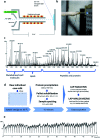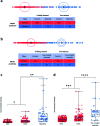LAP-MALDI MS coupled with machine learning: an ambient mass spectrometry approach for high-throughput diagnostics
- PMID: 35282613
- PMCID: PMC8826629
- DOI: 10.1039/d1sc05171g
LAP-MALDI MS coupled with machine learning: an ambient mass spectrometry approach for high-throughput diagnostics
Abstract
Large-scale population screening for early and accurate detection of disease is a key objective for future diagnostics. Ideally, diagnostic tests that achieve this goal are also cost-effective, fast and easily adaptable to new diseases with the potential of multiplexing. Mass spectrometry (MS), particularly MALDI MS profiling, has been explored for many years in disease diagnostics, most successfully in clinical microbiology but less in early detection of diseases. Here, we present liquid atmospheric pressure (LAP)-MALDI MS profiling as a rapid, large-scale and cost-effective platform for disease analysis. Using this new platform, two different types of tests exemplify its potential in early disease diagnosis and response to therapy. First, it is shown that LAP-MALDI MS profiling detects bovine mastitis two days before its clinical manifestation with a sensitivity of up to 70% and a specificity of up to 100%. This highly accurate, pre-symptomatic detection is demonstrated by using a large set of milk samples collected weekly over six months from approximately 500 dairy cows. Second, the potential of LAP-MALDI MS in antimicrobial resistance (AMR) detection is shown by employing the same mass spectrometric setup and similarly simple sample preparation as for the early detection of mastitis.
This journal is © The Royal Society of Chemistry.
Conflict of interest statement
There are no conflicts to declare.
Figures





Similar articles
-
Diagnostic Screening of Bovine Mastitis Using MALDI-TOF MS Direct-Spotting of Milk and Machine Learning.Vet Sci. 2023 Jan 31;10(2):101. doi: 10.3390/vetsci10020101. Vet Sci. 2023. PMID: 36851405 Free PMC article.
-
LAP-MALDI MS Profiling and Identification of Potential Biomarkers for the Detection of Bovine Tuberculosis.J Agric Food Chem. 2023 Sep 20;71(37):13899-13905. doi: 10.1021/acs.jafc.3c01879. Epub 2023 Sep 7. J Agric Food Chem. 2023. PMID: 37677086 Free PMC article.
-
Liquid Atmospheric Pressure Matrix-Assisted Laser Desorption/Ionization Mass Spectrometry Adds Enhanced Functionalities to MALDI MS Profiling for Disease Diagnostics.ACS Omega. 2019 Jul 26;4(7):12759-12765. doi: 10.1021/acsomega.9b01476. eCollection 2019 Jul 31. ACS Omega. 2019. PMID: 31460399 Free PMC article.
-
Matrix-assisted laser desorption ionisation (MALDI) mass spectrometry (MS): basics and clinical applications.Clin Chem Lab Med. 2020 Jun 25;58(6):883-896. doi: 10.1515/cclm-2019-0868. Clin Chem Lab Med. 2020. PMID: 32229653 Review.
-
MALDI-TOF Mass Spectrometry Technology as a Tool for the Rapid Diagnosis of Antimicrobial Resistance in Bacteria.Antibiotics (Basel). 2021 Aug 14;10(8):982. doi: 10.3390/antibiotics10080982. Antibiotics (Basel). 2021. PMID: 34439032 Free PMC article. Review.
Cited by
-
Integrating the milk microbiome signatures in mastitis: milk-omics and functional implications.World J Microbiol Biotechnol. 2025 Jan 18;41(2):41. doi: 10.1007/s11274-024-04242-1. World J Microbiol Biotechnol. 2025. PMID: 39826029 Free PMC article. Review.
-
Speciation analysis of fungi by liquid atmospheric pressure MALDI mass spectrometry.Anal Bioanal Chem. 2025 Sep 5. doi: 10.1007/s00216-025-06094-6. Online ahead of print. Anal Bioanal Chem. 2025. PMID: 40911099
-
Diagnostic Screening of Bovine Mastitis Using MALDI-TOF MS Direct-Spotting of Milk and Machine Learning.Vet Sci. 2023 Jan 31;10(2):101. doi: 10.3390/vetsci10020101. Vet Sci. 2023. PMID: 36851405 Free PMC article.
-
LAP-MALDI MS Profiling and Identification of Potential Biomarkers for the Detection of Bovine Tuberculosis.J Agric Food Chem. 2023 Sep 20;71(37):13899-13905. doi: 10.1021/acs.jafc.3c01879. Epub 2023 Sep 7. J Agric Food Chem. 2023. PMID: 37677086 Free PMC article.
-
Liquid Atmospheric Pressure Matrix-Assisted Laser Desorption/Ionization Mass Spectrometry Using a Commercial Ion Source and Orbitrap Mass Analyzer.Anal Chem. 2024 Oct 8;96(40):15865-15870. doi: 10.1021/acs.analchem.4c04458. Epub 2024 Sep 27. Anal Chem. 2024. PMID: 39331381 Free PMC article.
References
-
- Yamey G. Schaferhoff M. Aars O. K. Bloom B. Carroll D. Chawla M. Dzau V. Echalar R. Gill I. S. Godal T. Gupta S. Jamison D. Kelley P. Kristensen F. Mundaca-Shah C. Oppenheim B. Pavlin J. Salvado R. Sands P. Schmunis R. Soucat A. Summers L. H. El Turabi A. Waldman R. Whiting E. Lancet Glob. Health. 2017;5:E742–E744. doi: 10.1016/S2214-109X(17)30203-6. - DOI - PMC - PubMed
LinkOut - more resources
Full Text Sources
Research Materials

